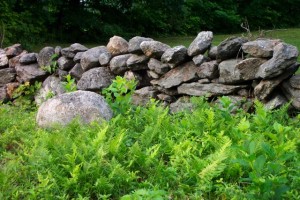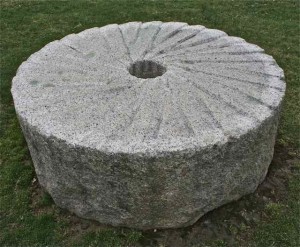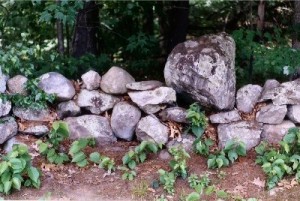
INTERESTING FACTS
These are described in more detail in the individual annotations.
- Where? Stone walls around former agricultural fields occur throughout the world. They are especially common in the British Isles and in New England.
- How many? There are too many to count. Certainly, there are tens of thousands of segments of stone walls.
- How long? If you added up all of the length of stone walls in New England and eastern New York, it would probably reach almost to the moon. One estimate is 240,000 miles.
- How high? Most walls reach higher than the knee of an adult but lower then the hip. This makes them about 2 feet high. Very few are chest-high or taller.
- How built? Most walls were made by simply setting stones on top of each other like cordwood or bricks. Carefully built ones, in which stone was quarried, hammered to fit, and carefully selected were built by craftsman.
- When? New England stone walls were built in the early 1600’s and continue to be built today. In inland regions of New England, however, most were built between the time of the American Revolution and the Civil War. A large portion of the walls was built in the fifty-year period between 1780 and 1830.
- Who? The farmers who cleared the fields built most stone walls, especially those that are not carefully laid. Many well-built walls were built as construction projects when low-cost labor was available, whether from wage earners, slaves, prisoners, or family members. A few stone structures, mainly concentrations, were build by Indigenous peoples.
- Why? Most stone walls, especially poorly constructed ones, were built to help hold the stone that had accumulated in fields. Often the stone was incorporated into a fence. Some stone walls were built specifically as fences, but this is rare. Even fewer were built for architecture’s sake.
REFERENCES FOR ADDITIONAL READING

Stone Wall Secrets Teacher’s Guide, 1998, by Ruth Deike (Gardiner, ME, Tilbury House) contains classroom exercises and a wealth of geological detail.
Exploring Stone Walls: A Field Guide to New England’s Stone Walls, 2005, by Robert M. Thorson, (New York, Walker & Company, 187 pages) provides details about the who, what, why, what, and where of stone walls.
Stone by Stone: The Magnificent History in New England’s Stone Walls, 2002, by Robert M. Thorson (New York, Walker & Company) provides a summary of the historic background.
Sermons in Stone, 1990, by Susan Allport, (New York, Norton, 205 pages) is a nicely written summary of the whole subject. It relies heavily on historical documents and oral tradition, and includes little geology.
Changes in the Land, 1983, by William Cronon, (New York, Hill and Wang, 241 pages) contains the best contemporary description of how European agricultural technology changed the forest ecosystem.
The Forgotten Art of Building a Stone Wall, 1971, by Curtis Fields (Dublin, NH. Yankee Publishing Co.) is a good “how-to” manual for those interested in building their own stone walls. Stone by Stone, 2002, by Robert Thorson (New York, Walker & Company) addresses many of the same themes as Stone Wall Secrets, but for the adult science trade market.
The Granite Kiss, 2001, by Kevin Gardner (Woodstock, VT, Countryman Press), a much improved version of the book by Fields above, is probably the single best source for stone walls.
Landscape and Material Life in Franklin County, Massachusetts, 1770-1860, 1994, (Knoxville, Univ. Tennessee Press) contains an excellent case study of landscape transformation from the archaeological point of view.
Written in Stone, 1989, by Chet Raymo and Maureen Raymo (Chester, CT, Globe Pequot Press, 163 pages) provides a full-length summary of the geological history of New England.
SELECTED POEMS BY ROBERT FROST

Mending Wall, from the collection “North of Boston” describes how walls tumble down and how frost heaving is involved in the process. Something there is that doesn’t love a wall.
A Star in a Stone Boat from the collection “New Hampshire” describes what Adam and Grampa found; the significance of a meteorite in a stone wall. Never tell me that not one star of all / that slip from heaven.
Fire and Ice from the collection “New Hampshire” alludes to the beginning and ending of the world, a central subject of our book. “Some say the world will end in fire. / Some say in ice/.”